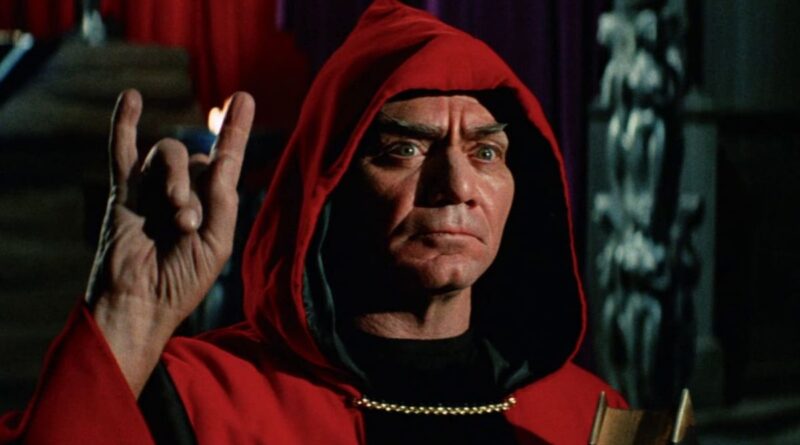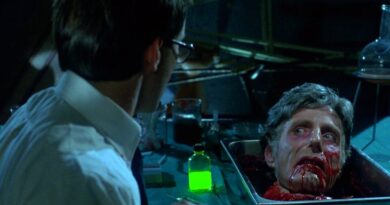The Devil’s Rain (1975)
With a different marketing campaign, and perhaps a little re-editing, The Devil’s Rain could have been an intentionally funny spoof of satanic horror films. But the filmmakers made the fatal mistake of taking the material seriously, and as such, it inspires the wrong kind of laughter – the kind that has nothing to do with amusement, but rather the utter disbelief that anyone thought something so awful would actually work. Given director Robert Fuest’s past experiences with campy horror – most notably The Abominable Dr. Phibes, in which Vincent Price devised the most hilariously elaborate revenge scenarios for the doctors who couldn’t save his wife from dying – I’m really surprised he didn’t know better going into this project.
Much like the equally awful Night of the Lepus, I’m utterly amazed at the names attached to The Devil’s Rain. As if Ernest Borgnine, William Shatner, Eddie Albert, Keenan Wynn, and Tom Skerritt weren’t bad enough, this film features Ida Lupino, who not only got to work with big names like Humphrey Bogart, John Garfield, and Edward G. Robinson, but also made a name for herself behind the camera as a writer, producer, and director, all fields that continue to be dominated by men. Why did she settle for this, and I mean for reasons besides a paycheck? Up-and-coming TV actor John Travolta also makes an appearance, albeit a brief one. I can’t help but feel bad for him. No matter where his career takes him, this will forever be his break into the movies.
The opening credits, in all seriousness, inform us that a technical advisor was Anton Szandor Lavey, High Priest of the Church of Satan. If I’m to believe this, I guess I also have to believe that Satanism involves baptisms that turn flesh-and-blood people into walking, talking life-size wax figures with no eyes. And that, although holding lit torches won’t affect them at all, water will melt them into piles of goo. Oh, and that the souls of the damned are contained within a beach-ball-sized faberge egg topped with a golden goat’s head, and has a window revealing souls screaming and pounding against the glass while standing in torrential downpours of rain. Funny – my Judeo-Christian understanding of hell is that it’s a pit of fire and brimstone. But a true satanic priest was an advisor on this film, so what do I know?
The plot involves a poorly-described curse affecting a family. It’s explained that the curse was placed by a satanic priest (Borgnine) sometime in the 1600s, having been betrayed by a member of his congregation. What isn’t adequately explained is how this priest was able to survive being burned at the stake and continue living for over 300 years without aging, currently leading his congregation in the abandoned church of a middle-of-nowhere desert ghost town. Has his own curse made him immortal? Does the fact that he can possess his own body with the soul of a demonic goat creature – which may or may not be Satan himself, I honestly don’t know – somehow factor into this? And how come his followers are all eyeless but he still has his own eyes?
Anyway, two members of the cursed family, a man (Shatner) and his mother (Lupino), are kidnapped by the cult and taken to the ghost town. This was done, I think, because this cult believes the family is in possession of a ledger containing the names of the satanic congregation – and yes, the names were all written in blood. The man’s brother (Skerritt) goes into the ghost town to rescue his family. He’s accompanied by his wife (Joan Prather), who, of course, has psychic visions and is introduced being experimented on by a doctor specializing in that field (Albert). Apart from one scene in which she’s able to see the past, specifically Borgnine’s execution in the 1600s, her sixth sense proves to have no bearing on the plot whatsoever.
But it’s really not her sixth sense that the filmmakers care about. They only care about providing the story with an obligatory female character that will invariably be captured by the cult, made to wear a white dress, and have symbols painted on her stomach with blood. However, in most satanic movies, there’s typically a narrative reason why this is done, usually (1) so the woman can carry the Devil’s offspring, or (2) to be offered as a sacrifice. If The Devil’s Rain provides a reason for why the Prather character is kidnapped and ritualistically prepped, it was entirely lost on me. So too was a plausible explanation for the final scene, which seems at great pains to make as little sense as possible. The same can be said for pretty much the entire movie, which gives a strange new meaning to the title House of Wax.




